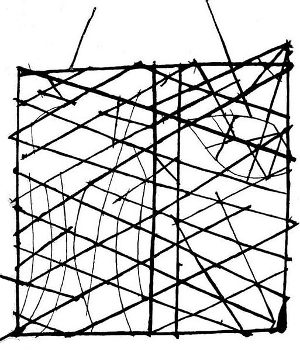
What is this? It’s a map. In order to navigate by canoe among the Marshall Islands, residents made charts by lashing together sticks, threads, and shells to represent landmasses and the patterns of ocean swells and breakers between them.
The atolls lie so low that even the tops of the palms are lost to sight 20 kilometers off shore, so a Marshallese navigator may spend several days out of sight of land. Having studied swell patterns with the aid of such charts, he can find his way by observing the motion of his canoe.
For example, an island breaks up the easterly trade wind swell, producing a wave pattern that signals the presence of land. “These navigation signs … extend seaward from any atoll or island in specific quadrants and can be detected up to 40 km away,” writes oceanographer Joseph Genz. “The relative strength of these radiating wave patterns indicates the distance toward land, while the specific wave signatures indicate the direction of land.”
(Joseph Genz et al., “Wave Navigation in the Marshall Islands,” Oceanography, June 2009.)
